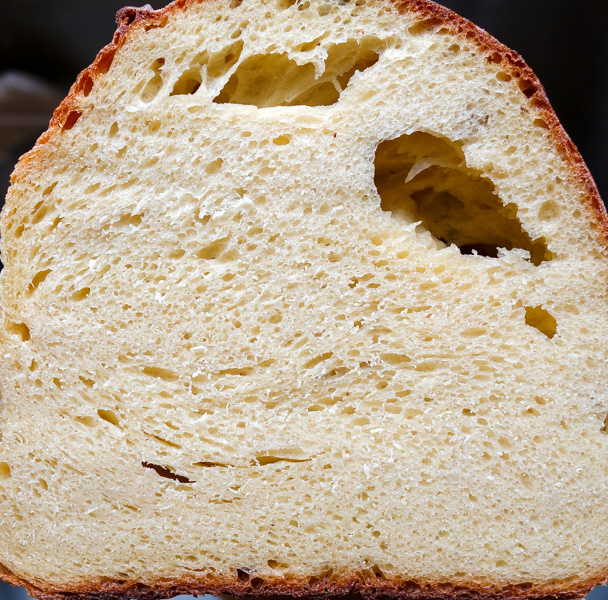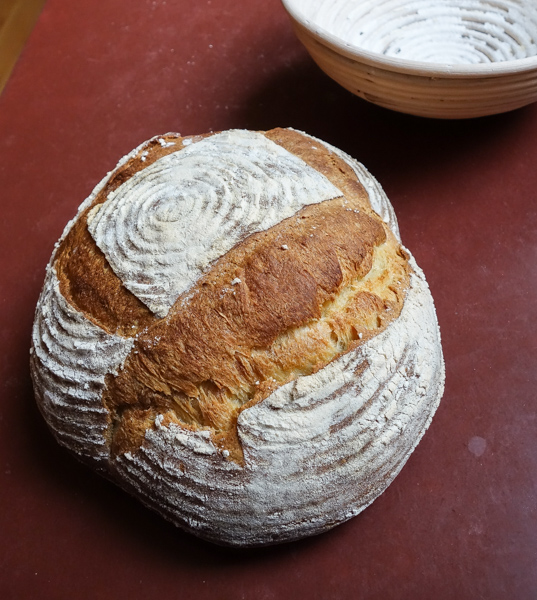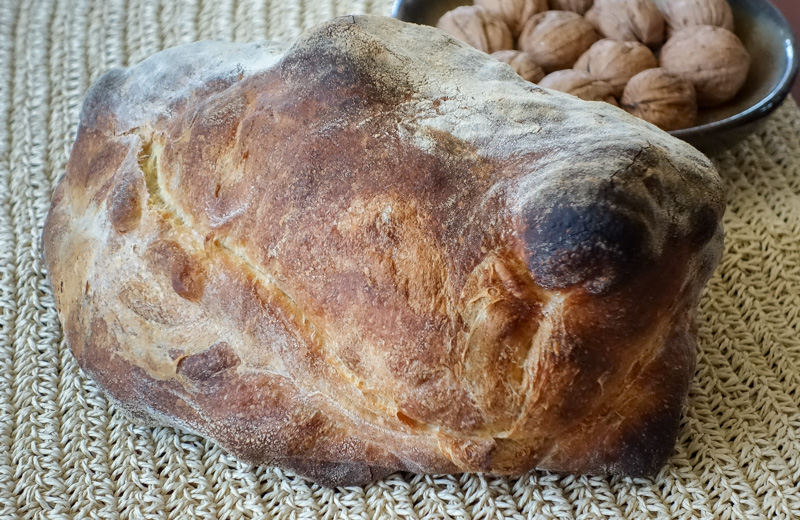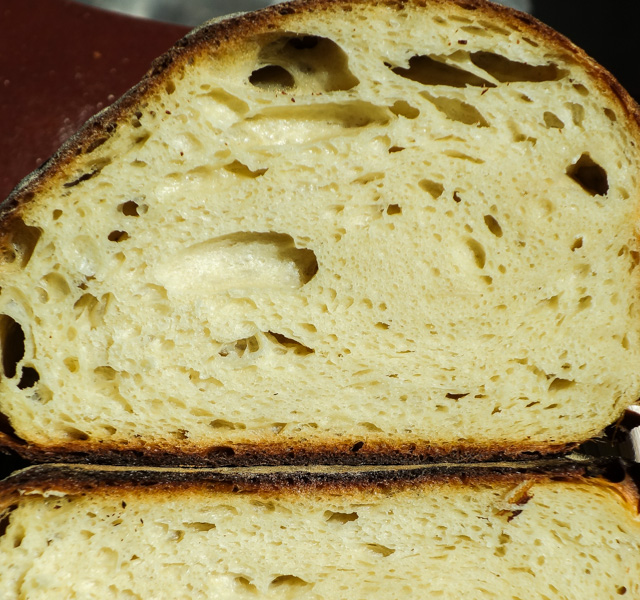
About a month ago I wrote about my attempts to reproduce a Pane di Altamura that I tasted on a visit to Italy. For the past few weeks I have been working on the formula and on my technique, and I’m happy to post my most recent results, which are much closer to the original look I was after. I researched the techniques a bit more and found some information I had missed the first time around. The key one was that I had not achieved sufficient gluten development. A post on TFL (with much thanks to nicodvb) described a 30+ minute knead to fully develop the dough, which was contrary to much of what I had read about gentle kneading requirements of durum. I had been doing S&Fs every 30 minutes previously and although the strength felt right, it was apparently insufficient. A couple of other important changes came from the D.O.P. document which said that the preferment should be 20% PFF (I was using 17.5% based on other recipes), and mixing the dough with cold (~55-60˚F) water. (While I perform these experiments I am keeping a 100% durum starter as well as my normal wheat starter.)
My two last bakes shown in the photos below differed primarily in the overall hydration. Most of the formulas available indicate hydration around 65% for Pane di Altamura, which I stuck with at first. The dough was easy to work with, but it was quite stiff, and the resulting crumb was very closed and tight. The aroma was lovely and taste was mild and somewhat sweet. The sourdough flavors were mostly undetectable. My shaping technique is still not perfect, although it is improving. The finished loaf is pictured at the top of the post and the crumb is shown here.

On the most recent bake I increased the hydration to 72%, more like the minimum I would use for a wheat-based sourdough. Keeping with 20% preferment, I split the batch into 2 loaves and shaped them into boules. One loaf was proofed for 2½ hours and baked as a boule. The second was retarded overnight, then shaped in the traditional folded loaf and baked the next morning. No steam was used during the bake and the oven was propped slightly open during the first 15 minutes of bake.

Active starter after 12 hour fermentation


Boule and crumb with 72% hydration dough.


Folded loaf and crumb
I plan to work with this general formula a bit more, making adjustments as the mood strikes:

17% prefermented flour using 110% hydration durum levain. This was based on a misreading of the regulations that the levain is 20% of the overall dough; it should actually be 20% prefermented flour. The levain was fermented for 12 hours at 75˚F with the ratio of seed:water:flour of 1:3.5:3
72% overall hydration (the calculation includes the levain)
100% patent durum extra fancy flour (fine grind, or Italian rimacinata)
1.9% salt
Final dough weight ~1300 grams (this large because it makes it easier for me to accomplish all the folding needed to shape the loaves) kneaded for at least 20 minutes, plus 4x S&F for the first 2 hours.
Bulk ferment 3 hrs @ RT, final proof 2½ hrs or retarded overnight.
Baked in a falling oven for 1 hour, starting at 460˚F and finishing at 400˚F, dropping the temperature in 2 steps, without steam.
They both had chewy crusts and the crumb less so, but had a bit of resistance. The folded loaf had noticeably more flavor and a more pronounced but not overpowering sour tang and came out really tasty. Another major difference was that the crumb of the boule that was scored was drier than the boule shaped in the folded loaf form, which was quite moist. They were baked with roughly the same temperatures and times but clearly the scores allowed more water to evaporate. They both had thick crusts reminiscent of the authentic loaf. I plan to extend the baking time and lower the temperature more quickly for the next folded loaf to dry it out a bit more.
-Brad
- breadforfun's Blog
- Log in or register to post comments
Thanks for reporting on your progress, Brad! The last bread looks especially good to me and much like the photos I've seen of the original.
I've not been to Altamura so I don't have the reference point you do, but I would love to be able to bake an authentic replica of this famous bread.
David
These loaves came out pretty good - they're tasty, have a lovely golden crumb and honey colored crust like the original. It's maybe 80% of the way there and I may yet get closer. But the last little bit comes from a wood-fired oven, which at this point I have no access to and no prospect of getting access. Now, if you wanted to include this loaf in your experiments with the WFO you may well get a lot closer than me...
-Brad
Funny you should mention! An attempt at this bread was in my mind for a WFO trial. My next WFO is not yet scheduled, but I will definite keep this in mind.
David
Well, I don't really think that this loaf is all that close to the original, but it's probably about 80% of where I'll end up and call the project a success. Good luck with the WFO whenever it happens.
-Brad
used in Altamura - what shape are you using for this fine loaf and how are you shaping / folding it? It looks like a fossilized dinosaur waste heap.........
Your experiments are really paying off. and the crumb is really glossy and the sun really brongs out the beautifil yellow color of the crust and crumb. Well done abd Happy baking
Hi DA - the shape I'm trying to make is called u sckuanete, sometimes called folded or overlapped loaf. Fortunately it tastes better than (I'd imagine) dinosaur coprolite, though I see your point. Some photos can be found here and here and here. My shaping technique, as such, is from this video.
-Brad
I actually like the rustic fab look of fossilized dinocorprolite and want to include it in our normal repertoire of Altamura breads. It's a same you can't get a T-Rex slash on it somewhere:-(
Happy baking
PS what a great Altamura shaping video! Now I see why it is 65% hydration;;;;I think we can get a T-Rex slash on it too if he can stamp it :-)
Hey Beavis, did you hear that? I think he just said "poop".
...out of the mouths of babeskers...
Congrats on your progress. The bonus is you get to eat all the test runs!
Cathy
...that I've got a freezer full of failures. Anyone need breadcrumbs?
Thanks for your encouragement, Cathy.
-Brad
My first impression of the first loaf was a bit different... I was thinking Altamira and cave art. But even upside down and perhaps added red ochre couldn't get me to see a sleeping buffalo.
Try feeding the sd starter some of the altus and give it a good mix in preparation for dough.
Mini
Mini,
Nice idea to use the failures as altus. In rye breads doesn't it have the effect of keeping the crumb moist? It's worth a try.
-Brad
Really lovely and tasty looking loaf there Brad. I really like the yellowness of this bread. The crust looks perfect to me comparing it to the authentic Altamura breads online. You must be happy with this bake.
Now I'm wondering something... what do they mean by 20% levain? I always thought that it was the flour + starter. Straight forward 20% starter you're adding into the dough. But the timing is very specific and it does seem very short for that amount of starter. So could the 20% starter they're talking about be just the flour within the starter. This would actually make a much higher percentage levain making more sense for the shorter bulk fermentation and final proofing time. I'm also quite sure the specifics were a 65% final hydration dough.
What do you think?
Quote: "This was based on a misreading of the regulations that the levain is 20% of the overall dough; it should actually be 20% prefermented flour".
I should learn to read properly.
I will try this next time as my two previous attempts were 20% levain and not 20% as inoculant flour.
Does the recipe specify the salt amount? If not then to accommodate the short fermentation times then how about knocking back the salt to 1.5% so the yeast is less inhibited.
Now I'm going to re-read your post Brad as you've probably talked about this.
I was pretty happy with the bake. As for the salt, the regulations specify 2%. Below is the section describing the general dough formula. I'm not sure that reducing it to 1.5% will have much impact on the leavening power, but give it a try.
What is curious to me is the detail to which they specify the water mineral content. I wonder if they did studies to optimize this or simply measured the water of the DOP region. There is also a seeming contradiction: in point 2. the water is specified to be 18˚C while in the second tick under 3 it is 12-15˚C. The overall hydration is supposed to be 60%, but viewing any of the videos it's hard for me to believe that the doughs are actually that low.
-Brad
some Altamura spec's. Supposedly the water has to be from the region to be authentic.and why the spec's for it are as they are.
http://www.myitaliansmorgasbord.com/2013/08/08/breads-of-italy-pane-tipo-altamura/
And
http://atcast.typepad.com/files/pane-di-altamura-dop.pdf
for the standards themselves
After all, the point of the DOP is to protect the products of the region.
Thanks for the blog link - I hadn't seen that one. I will start to call my loaves Pane Tipo di Altamura. She's using quite a high hydration dough, in excess of 83% overall. Of course, she's not doing secondary shaping - the boules are indeed easier.
-Brad
If 2% salt it is then 2% it shall be. Well you have established its 20% flour in the starter and not 20% starter. So I guess if I do 2% of flour excluding the starter then it will be less then my previous attempts. I'm just trying to figure out the seemingly puzzling short fermentation times. Anyways, so your post has inspired me to delve into this again and I've been doing more research. Turns out my last two attempts were done with Semolina! The more course grind. Terminology is so confusing. What the correct flour is, is Remilled Semolina Flour or Semola Remacinata. I went back to the Italian store and they had plenty and always stock it. Good to know because its difficult to find. Bought two packets for a small fortune. £3.90 for 1kg which is about $6.40. Now I know what they mean, this is more like flour!
Wish me luck.
- Abe.
Abe,
I agree that there is a disparity between the amount of levain and the short fermentation times. I didn't follow their fermentation recommendations - I found the dough needed quite a bit more, so there is something they are not telling us here, maybe higher temperatures. And, yes, the rimacinata is quite expensive in the small 1kg packages here as well. There is a local store that sells bulk grains and flours that I go to, but of course they don't carry the imported stuff. I paid around $1.75/lb or $3.85/kg (that's around £2.55/kg or about a third less than you).
And just to complicate matters even more, the regs specify the varieties of durum wheat that are to be used, but I have no idea what the differences are. See the discussion with dabrownman - it's likely that they wrote the DOP regs based on what they actually do there in Altamura since it is meant to protect them. We should probably be calling it Pane Tipo di Altimura if we don't want the powers that be coming after us.
Good luck.
-Brad
Thanks Brad. Been doing a bit more delving and pretty confident the final hydration should be 67%
Now I must admit I have to assume the pre-ferment or starter build is 100% hydration. The only information we have is that the flour within the levain should be 20% of flour in the recipe and that it should be done over 3 builds. Now I'm sure if the hydration was less or more than 100% it would be specified (?).
Now let's go onto the wording of the actual dough... Quantities and composition of the mix: 100kg durum-wheat flour requires 20kg (20%) leaven, 2kg (2%) sea salt and approximately 60 litres (60%) water at a temperature of 18C.
Now they aren't saying 60% final hydration. It clearly says the amounts of flour + water + salt + leaven. If we understand it like so then it'll always come to 67% final hydration. They do say approximately of course as when it comes to making a dough there will be slight variations according to the flours needs but it does put you in the ball park.
Now I'm looking into the mineral content of the water :)
brb.
Good luck Abe, can't wait to see your results!
-Brad
Abe. i would shoot for 67% hydration overall. 60% is too low for the dough being handled in the video but looks right for 67. Can't wait to see your finished Dino Pile
Happy Crapola Formng
The first of 3 builds has commenced. 3 builds it requires and 3 builds it shall get.
Build one.: 10g of Brad's Starter + 10g water + 10g Semola Remacinata
Build Two: 30g from build 1 + 30g water + 30g Semola Remacinata
Build 3 (day of): 90g from build 2 + 55g water + 55g Semola Remacinata
We have a 1:1:1 build for the first 2. Then a slightly bigger build than 1:0.6:0.6 for the final build. It is day of and the starters maturity will be quicker as planned.
The recipe will be as follows...
500g Semola Remacinata
300g water
10g salt
200g levain
Method:
Mix flour + 214g water + salt + levain and knead for 15min
Add remaining 86g water and knead for 5min till silky smooth dough
Bulk ferment for 2 hours
Shape into boule and final proof for 30min (that's in the D.O.P. instructions)
Then flip boule over into the traditional shape and bake the hell out of it for 1hr (that's my wording). 220C for 45min and 180C for 15min.
Fingers crossed.
Crapola Forming is my speciality. Funnily enough I always seem to end up with something resembling a Dino Pile. But watch me muck this up and create a perfectly formed beautiful artisan loaf. S*ds Law.
Anche la forma riprende molto il Pane di Altamura e molto bella anche la consistenza della mollica.
Bellissima la cottura della crosta, complimenti.....
Dalla Toscana con simpatia.
Anna
Ha bisogno di ancora più lavoro. Questo è il più vicino ho ottenuto fino ad ora. Ma io non voglio raggiungere l'obiettivo in modo che posso visitare di nuovo.
Ciao.
-Brad
And things are going really fast now.
1st build of 10:10:10 took time expected
2nd build of 30:30:30 is going very fast. I think its going to rise and fall well before I wake in the morning. I'm off to bed in a minute so nothing I can do.
3rd build will be 90:55:55 and then onto recipe. I suspect this will take hardly any time.
Perhaps this is peculiar to this flour. I've done builds like this before and never has it been this fast. Perhaps this is the reason for 3 builds and the seemingly peculiar short fermentation time in the recipe.
Lovely smelling starter though. Its the best I've ever smelled. Gone from cookie dough to raisins. Let's see what the 3rd build brings.
Hi Abe,
I have also found that durum ferments faster than wheat. If you need to leave it unattended you may want to reduce the seed amount in your final build. Or increase the other components to dilute it.
Your nose is more sensitive than mine to pick out cookie dough and raisins!
-Brad
Here's a pic of a loaf MIL brought home for me from her trip to Southern Italy.
Thanks for sharing, Mini. That elusive shape again, but it is a beautiful loaf. How does it taste?
-Brad
impressed with the taste, much like a normal plain white bread or two day old baguette. If you want more pictures just say so.